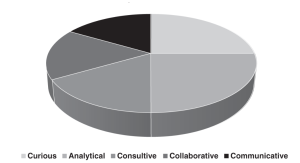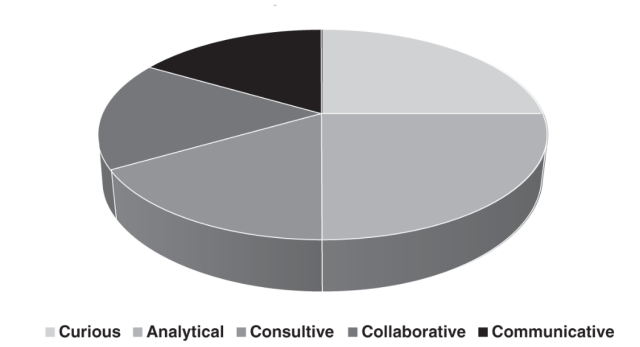
Artificial Intelligence (AI) has become an integral part of many organizations’ operations. From customer service to supply chain management, AI is increasingly being used to automate and streamline processes. However, AI can do more than just help you run your business more efficiently; it can also be used to build organizational culture and foster data-driven decision making in general while leveraging analytical tools & techniques. Let’s take a look at how AI-powered organizational and cultural traits can help improve the workplace. The following picture is a summary of cultural traits in AI-driven organization
Be Curious
The adoption of artificial intelligence (AI) within an organization can enhance curiosity in several ways.
AI can help create a culture of experimentation and exploration within the organization. By providing tools and capabilities that allow employees to easily test and evaluate different ideas and hypotheses, AI can encourage a spirit of curiosity and a willingness to try new things.
AI can help to provide insights and information that can spark curiosity and inspire further investigation. By analyzing and synthesizing large amounts of data, AI can uncover trends and patterns that may not be immediately apparent to human observers. This can help to generate new questions and ideas, and to inspire employees to dig deeper and explore further.
The use of AI for predictive modeling and decision-making can open up new possibilities and opportunities for an organization. By providing more accurate and timely predictions and recommendations, AI can help to drive innovation and experimentation, leading to increased curiosity and a desire to learn more.
Enhance Analytical Thinking
Need for adopting AI-powered solutions within an organization can enhance analytical thinking by providing new tools and approaches for data analysis and decision-making. AI algorithms and systems are designed to process and analyze large amounts of data quickly and accurately, which can help to facilitate more in-depth and sophisticated analysis.
The use of AI can also help to foster a culture of analytical thinking within an organization by providing tools and resources that enable team members to easily access and analyze data, test hypotheses, and explore new ideas. This can help to create a more data-driven and evidence-based environment, where team members are encouraged to think critically and to make decisions based on data and analysis.
Be Consultative
AI-powered solutions create an environment for informed discussions based on AI-driven insights, on-going training on consuming newer insights, and interactive discussions to capture business problems in detailed manner to leverage intelligence based on AI solutions..
Be Collaborative
AI can help to break down silos and foster collaboration within the organization. By providing a common language and framework for data analysis and decision-making, AI can facilitate communication and coordination across different teams and departments. This can help to create a more collaborative and curious environment, where employees are more likely to share their ideas and experiences, and to learn from each other in order to foster the culture of data-driven decision making.
Be Communicative – Foster Storytelling
Organizations that have adopted AI into their operational processes are quickly realizing the importance of storytelling for successful communication. Storytelling has become a key part of communication for these AI-powered organizations, as it allows them to effectively communicate their message through a narrative. By utilizing storytelling techniques, organizations can better express their ideas, thoughts and feelings in a way that is easier to understand and more engaging than traditional methods of communication.
Storytelling is especially important for AI-powered organizations because it allows them to create a more personalized and powerful narrative than they might otherwise achieve. For example, stories provide an opportunity to share how AI and data science can be used to improve customer experience or provide meaningful insights into difficult business decisions. Additionally, stories help these organizations explain complex concepts in simple terms that are easy for customers or other stakeholders to understand.
By leveraging storytelling techniques alongside AI-powered operations, companies can effectively communicate their message while also building strong relationships with their customers. Storytelling provides an opportunity for companies to express themselves through compelling narratives that engage customer attention while illustrating their commitment towards innovation and progressiveness in technology solutions. As such, it is essential that AI-driven organizations prioritize storytelling as an integral part of communication if they wish to remain competitive while fostering customer engagement at the same time.
- Chunking Strategies for RAG with Examples - November 2, 2025
- RAG Pipeline: 6 Steps for Creating Naive RAG App - November 1, 2025
- Python: List Comprehension Explained with Examples - October 29, 2025

I found it very helpful. However the differences are not too understandable for me